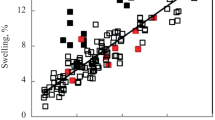The results of post-reactor studies of U0.55Pu0.45N and U0.4Pu0.6N mixed mononitride fuel elements (density 85% of the theoretical value) and a helium sublayer are presented. The fuel elements are irradiated in a BOR-60 reactor to burnup 9.4 and 12.1% h.a., respectively, with power density 430 and 540 W/cm. All fuel elements remained hermetic; the ChS-68 steel cladding (20% cold deformation) retained excess plasticity. The maximum zone of interaction between the cladding and the fuel and fission products did not exceed 15 μm. The swelling rate of U0.4Pu0.6N and U0.55Pu0.45N fuel was 1.1 and 0.68%/% burnup, respectively. The gas release did not exceed 19.3 and 19%. The steel damage dose was 43 dpa. The character of the porosity distribution in the fuel affects the swelling and gas release.
Similar content being viewed by others
References
V. V. Orlov, B. F. Gromov, E. O. Adamov, et al., “Unconventional concepts of inherently safe nuclear power plants,” At. Énerg., 72, No. 4, 317–323 (1992).
V. V. Orlov, A. G. Sila-Novitsky, V. Smirnov, et al., “Mononitride fuel and large scale nuclear power industry,” in: Proc. of Technical Committee Meeting Held in Moscow on Studies of Fuels with Low Fission Gas Releases, IEA-TECDOC-970 (1996), pp. 155–168.
F. G. Reshetnikov,Yu. K. Bibilashvily, B. D. Rogozkin, et al., “Production and studies of U and Pu nitrides as nuclear fuel and forms of weapons grade plutonium storage,” in: Global (1995), Vol. 2, pp. 1259–1366.
B. D. Rogozkin, N. M. Stepennova, Yu. E. Fedorov, et al., “Mononitride mixed fuel for fast reactors,” in: Tech. Comm. on Unconventional Options for Pu Disposition, IAEA-TECDOC-840 (1994), pp. 229–236.
B. D. Rogozkin, V. V. Orlov, A. G. Sila-Novitsky, et al., “Properties and synthesis and radiation reprocessing technology of mononitride fuel for inherently safe reactors,” in: Intern. Top. Meeting on Advanced Reactor Safety, IAEA-TECDOC (1994), pp. 229–234.
A. A. Mayorshin, L. M. Zabudko, B. D. Rogozkin, et al., “Irradiation of oxide and nitride fuels and also fuel in the inert matrix with high plutonium content in the BOR-60 reactor. Status of Russian–French experiment BORA-BORA,” in: Global (2003), pp. 1989–2005.
L. M. Zabudko, A. A. Kamaev, L. I. Mamaev, et al., “Nitride fuel for advanced fast sodium reactors,” in: Global (2003), pp. 1679–1685.
BOR-60. Irradiation Experiment Specification Note Tgechnique SCD/LCI 97-2044 (DR), Indice O/De, CEA, Cadarache (1997).
M. Inoue, T. Iwai, Y. Arai, and T. Asaga, “Irradiation performance of uranium–plutonium mixed nitride fuel pins in JOYO,” in: Global (2003), pp. 1694–1703.
B. D. Rogozkin, N. M. Stepennova, G. A. Bergman, and A. A. Proshkin, “Thermochemical stability, radiation tests, fabrication, and regeneration of mononitride fuel,” At. Énerg., 95, No. 6, 428–438 (2003).
Studies on Fuels with Low Fission Gas Release, IAEA-TECDOC-970 (1997).
Y. Arai, Y. Suzuki, T. Iwai, et al., “Fabrication of uranium-plutonium mixed nitride fuel pins for irradiation tests in JMTR,” Nucl. Sci. Techn., 30, No. 8, 824–830 (1993).
V. D. Dmitriev, L. I. Moseev, and A. G. Vahtin, “Capacity for work mononitride fuel in reactor BR-10 with burning until 8.2% h.a.,” in: 3rd Conf. on Reactor Materials, Dimitrovgrad, Russia (1993), pp. 46–51.
T. Iwai, K. Nakajima, H. Kikuchi, et al., “Post-irradiation examination uranium-plutonium mixed fuel irradiated in JMTR,” in: JAERI-Research (2000), pp. 1–57.
B. D. Rogozkin, N. N. Stepennova, O. A. Ustinov, et al., “Nitride fuel and its perspective use in fast reactors,” in: New Generation of Future Systems for Nuclear Energy, Emphasizing Proliferation Resistance Issues, CEA–IBRAE (2002), pp. 1–15.
M. Ya. Khmelevskii, E. I. Malakhova, and V. V. Popov, “Physical and mathematical fundamentals of the calculation of the stress–strain state and serviceability of container-type cylindrical fuel elements,” Preprint FEI-3007 (2003).
L. M. Zabudko and A. A. Trufanov, “Investigation of the serviceability of fuel elements of the BN reactor core with nitride fuel based on existing domestic and foreign experimental data,” Preprint FEI-2964 (2002).
V. D. Dmitriev, S. I. Porollo, A. N. Vorobiev, et al., “Investigation of the swelling and mechanical properties of 06Kh16H15M2G2TFP steel fuel-element cladding after irradiation in the BN-600 reactor according to the damaging dose 87.5 dpa,” in: Int. Conf. on Radiation Materials Science, KhFTI, Kharkov (1990), Vol. 3, pp. 49–55.
I. A. Portnykh, A. V. Kozlov, V. L. Panchenko, and V. M. Chernov, “Effect of stress on the radiation swelling of Kh16H15M2G2T (ChS-68) steel under high-dose neutron irradiation,” Vopr. At. Nauki Tekhn. Ser. Materialoved. Nov. Mater., No. 1(66), 371–379 (2006).
K. Tanaka, K. Maeda, K. Katsuyama, et al., “Fission gas release and swelling in uranium-plutonium mixed nitride fuels,” J. Nucl. Mater., 327, 77–87 (2004).
Author information
Authors and Affiliations
Additional information
Translated from Atomnaya Énergiya,Vol. 110, No. 6, pp. 332–346, June, 2011.
Rights and permissions
About this article
Cite this article
Rogozkin, B.D., Stepennova, N.M., Fedorov, Y.E. et al. Results of U0.55Pu0.45N and U0.4Pu0.6N mixed mononitride fuel tests in a bor-60 reactor to burnup 12% h.a.. At Energy 110, 412–429 (2011). https://doi.org/10.1007/s10512-011-9442-0
Received:
Published:
Issue Date:
DOI: https://doi.org/10.1007/s10512-011-9442-0



